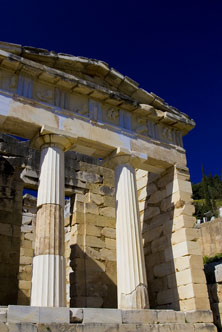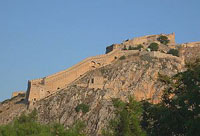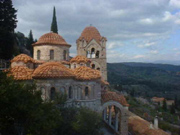|
|
|
|
|
Special
Tours
TOUR
1: FULL DAY AEGINA
ISLAND TOUR
you
will take the morning ferry from Piraeus port to Aegina
and the trip will take about 1h20m. Aegina was the capital
of Greece from 1827 to 1829. Aegina Town is situated on
the west side of the island where the main port of the island
is located. Agios Nikolaos, the tiny church, welcomes the
visitor on approaching Aegina by sea. Numerous neoclassical
buildings dominate Aegina Town, reminding the visitor of
the glory of the island. You will visit the Archaeological
Site of Kolona [The Hill of kolona was
inhabited in prehistoric times through the classical period.
Extensive walls and foundations have been discovered and
excavations are still in progress. One erect column is all
that remains of a Temple of Appolo built in the 6th c. BC.],
The Museum [which contains a small but
rich collection of pottery and sculpture from all periods
of Aegina's history. One of the most significant exhibits
is the statue of the Sphinx (460 BC), which was dedicated
to the Temple of Appolo. It is an extraordinary sculpture,
with a head of a woman and a body that is half eagle and
half lion, (Tues-Sun 08:30-15:00, Ticket: Full 3 Euros -
Reduced 2 Euros)], The Church of Agios Nektarios
[which is named after its patron, Agios Nektarios, who died
in 1920 and was canonised in 1961. His memory is celebrated
by the Church on 9 November], The Temple of Aphaia
[stands on top of a pine-clad hill above Agia Marina. The
first temple on the site (700 BC) was dedicated to Aphaia,
a deity from Crete. The Doric temple we see today was built
about 490 BC of local porous sandstone, On a clear day,
you can make out the Temple of Poseidon at Sounio, as well
as the Acropolis of Athens. It is said that the three temples
form an isosceles triangle (the sacred triangle of antiquity).
(Daily 08:00-17:00, Museum: Tues-Sun 08:30-14:15, Ticket:
Full 4 Euros Reduced 2 Euros)]. You will also have lunch
in a nice taverna, swim in one of the best beaches and take
the afternoon ferry back to Piraeus.
TOUR
2: FULL DAY WINE TASTING & HISTORY TOUR
combines
history with the natural beauties of Greece. Includes: The
Canal (which is about 6 km long and connects
the Aegean Sea with the Ionian Sea; its width upon completion
was 25 meters, and 8 meters deep), Ancient Corinth
(where you can see the Long Walls that begin at the summit
of Acro-Corinth and descend all the way to Lechaion, the
artificial harbour on the Corinthian Gulf, the Agora, the
Dorian Temple of Appollo [6th c. BC with 1st c. AD restorations],
the museum which contains mosaic floors, Mycenaean and Corinthian
pottery, terra cotta sphinxes, statues of two supernatural
beings, relief plaques, the Roman head of the goddess Tyche
and small objects of various kinds, and the Bima where St
Paul preached), Acro-Corinth (the fortress
acropolis of Ancient Corinth and Medieval Corinth, being
on a steep of a rocky hill 575 meters high at its highest
peak, with uninterrupted views across the Corinthian and
Saronic Gulfs. It has been a fortified citadel for the Mycenaens,
Archaic Greeks, Macedonians, Romans, Byzantines, Franks,
Venetians, Ottomans and eventually back to the Hellenes
following the Greek War of Independence), and finally Nemea
(where you can taste some of the best wines made in the
region [Agiorgitiko: Saint George]).
TOUR
3: FULL DAY ATHENS TOUR WITH JEWISH SITES
includes
a visit to: The Acropolis (where you will
see the Temple of Parthenon which is dedicated to Athena
Parthenos, Propylea which is the monumental entrance to
the sacred area, the Temple of Athena Nike which is dedicated
to Athena-Apteros Nike, the Temple of Erechtheion which
is dedicated to Athena Polias, the Cariatides, Herodeon
Theater, the ruins of the Theater of Dionysus, Areopagus
(Mars Hill), The Jewish Museum (which was
first established in 1977. Its collection includes more
than 10,000 rare artifacts of great historical significance.
This unique collection is continuously enriched and updated),
The Temple of Zeus (which is the largest
ancient temple in Greece in the Corinthian order), The Panathenaic
Stadium (also known as The Kallimarmaro, the original
stadium built in the 1863 for the first modern Olympic games
in 1896), The Old Palace, The Tomb
of The Unknown Soldier in front of the Parliament
& The Changing of The Guards, The Jewish
Synagogue (which is the oldest synagogue in Athens.
It was built in 1906 and is currently used only during the
High Holidays. The synagogue is maintained by the Jewish
Community of Athens), The Plaka (which
is Athens oldest and most picturesque neighborhood. It is
stone-paved, with narrow streets, and is full of gyros places,
tavernas and souvenir shops) for lunch, The Greek
Agora (which was the civic, religious and commercial
center of the Athenian life set with appropriate buildings
like the Stoa of Attalus [now, since its restoration, is
used as a Museum housing interesting findings] and The Temple
of Hephaistus).
* Please note that The Jewish Museum and
The Synagogue are closed on Saturdays so
they are replaced either by The Roman Agora (where the Tower
of Winds stands [which is an octagonal pentelic marble clock
tower] or by The New Acropolis Museum.
TOUR
4: HALF OR FULL DAY CORINTH CANAL VISTA TOUR
includes
a cruise of: the famous Corinth Canal which
is about 6 km long, only 21.3 meters wide at its base and
connects the Aegean Sea with the Ionian Sea. It cuts through
the narrow Isthmus of Corinth and separates the Peloponnesian
peninsula from the Greek mainland, thus effectively making
the former an island. Although, it has been completed in
the late 19th century, it was an idea and dream that dates
back to over 2000 years. Emperor Nero (67 CE) had employed
6,000 slaves for the job. He started the work himself, digging
with a golden hoe, while music was played. However, he was
killed before the work could be completed. The cruise starts
around 11:00 and lasts about 1h30m.
Optionally
you can extend the tour and visit some other popular sites
in Peloponnese. Ancient Corinth (where
you can see the Long Walls that begin at the summit of Acro-Corinth
and descend all the way to Lechaion, the artificial harbour
on the Corinthian Gulf, the Agora, the Dorian Temple of
Appollo [6th c. BC with 1st c. AD restorations], the museum
which contains mosaic floors, Mycenaean and Corinthian pottery,
terra cotta sphinxes, statues of two supernatural beings,
relief plaques, the Roman head of the goddess Tyche and
small objects of various kinds, and the Bima where St Paul
preached), Acro-Corinth (the fortress acropolis
of Ancient Corinth and Medieval Corinth, being on a steep
of a rocky hill 575 meters high at its highest peak, with
uninterrupted views across the Corinthian and Saronic Gulfs.
It has been a fortified citadel for the Mycenaens, Archaic
Greeks, Macedonians, Romans, Byzantines, Franks, Venetians,
Ottomans and eventually back to the Hellenes following the
Greek War of Independence), Diolkos (which
was a paved trackway near Corinth on Ancient Greece, which
enabled boats to be moved overland across the Isthmus of
Corinth. The shortcut allowed ancient vessels to avoid the
long and dangerous circumnavigation of the Peloponnese peninsula)
and finally Nemea (where you can taste
some of the best wines made in the region Agiorgitiko: Saint
George).
TOUR
5: HIKING IN LOUSIOS GORGE
In
Lousios Gorge (a five kilometer gorge with
several hiking trails, and a very good bridge crossing Lousios
river) you can walk from one village to another following
a dirt road through the mountains in beautiful scenery that
even has some small waterfalls. The Lousios river is where
Zeus used to bath himself, in the spectacular densely vegetated
gorge and in the river s crystal clear waters.
TOUR
6: BATTLE GROUND OF THERMOPYLAE & MUSEUM
Where
you will see a modern-day monument of King Leonidas
I of Sparta. Thermopylae means hot gates in Greek.
This is derived from the myth that Heracles had jumped into
the river in an attempt to wash off the Hydra poison imbibed
in the cloak that he could not take off. The river was said
to have turned hot and stayed that way ever since.

|
|



